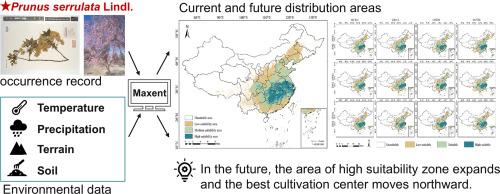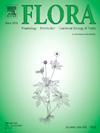山李适宜种植面积的预测。在未来气候变化的背景下
IF 1.8
4区 生物学
Q3 ECOLOGY
引用次数: 0
摘要
全球气候变化深刻地重塑了物种分布格局。山李。作为中国重要的观赏树种,具有很高的经济和美学价值,可作为评估此类影响的理想模型。物种分布模型已成为评估气候变化下物种潜在分布的重要工具。利用高AUC值(0.938)验证的最大熵(MaxEnt)模型,综合127条发生记录和13个环境变量,预测了4种CMIP6情景(SSP126、SSP245、SSP370、SSP585)下其当前和未来的分布。结果表明,最干旱月降水量(Bio14,贡献32.5%)、最湿月降水量(Bio13,贡献18.4%)、最冷月最低气温(Bio6,贡献18.2%)、海拔(海拔,贡献13.1%)和等温(Bio3,贡献3.9%)5个因子是影响柽柳分布的主导因子。目前,高适宜区(52.65万平方公里,占中国国土面积的5%)集中在长江中下游。未来的预测表明,到2041-2060年,高适宜性区域将扩大5 - 15%,在SSP585情景下达到峰值,而分布质心将向东北移动220-300 km,表明可能发生耕地迁移。该方法为种质资源的引种和保存、木参的培育、花蕾休养园布局的优化、城市植被生态效益的提升、观赏特色的审美情趣等提供了科学依据。本文章由计算机程序翻译,如有差异,请以英文原文为准。

Prediction of suitable areas for Prunus serrulata Lindl. in the context of future climate change
Global climate change profoundly reshapes species distribution patterns. Prunus serrulata Lindl., a critically important ornamental species in China with high economic and aesthetic value, serves as an ideal model to assess such impacts. Species distribution modeling has become a key tool to evaluate the potential distribution of species under climate change. Here, using the maximum entropy (MaxEnt) model validated by a high AUC value (0.938), we integrated 127 occurrence records and 13 environmental variables to project its current and future distribution under four CMIP6 scenarios (SSP126, SSP245, SSP370, SSP585). The results showed that the five factors of driest monthly precipitation (Bio14, 32.5 % contribution), wettest monthly precipitation (Bio13, 18.4 %), coldest monthly minimum temperature (Bio6, 18.2 %), elevation (elev, 13.1 %), and isothermality (Bio3, 3.9 %) were the dominant factors affecting the distribution of P. serrulata. Currently, high-suitability areas (526,500 km², 5 % of China) are concentrated in the middle and lower reaches of the Yangtze River. Future projections indicate a 5–15 % expansion of high-suitability areas by 2041–2060, peaking under SSP585 scenario, while the distribution centroids shift northeastward by 220–300 km, suggesting potential relocation of the cultivation zone. This method provides a scientific basis for introducing and preserving germplasm, cultivating P. serrulata, optimizing bud dormancy garden layouts, enhancing the ecological benefits of urban vegetation, and increasing the aesthetic appeal of ornamental features.
求助全文
通过发布文献求助,成功后即可免费获取论文全文。
去求助
来源期刊

Flora
生物-植物科学
CiteScore
3.30
自引率
10.50%
发文量
130
审稿时长
54 days
期刊介绍:
FLORA publishes original contributions and review articles on plant structure (morphology and anatomy), plant distribution (incl. phylogeography) and plant functional ecology (ecophysiology, population ecology and population genetics, organismic interactions, community ecology, ecosystem ecology). Manuscripts (both original and review articles) on a single topic can be compiled in Special Issues, for which suggestions are welcome.
FLORA, the scientific botanical journal with the longest uninterrupted publication sequence (since 1818), considers manuscripts in the above areas which appeal a broad scientific and international readership. Manuscripts focused on floristics and vegetation science will only be considered if they exceed the pure descriptive approach and have relevance for interpreting plant morphology, distribution or ecology. Manuscripts whose content is restricted to purely systematic and nomenclature matters, to geobotanical aspects of only local interest, to pure applications in agri-, horti- or silviculture and pharmacology, and experimental studies dealing exclusively with investigations at the cellular and subcellular level will not be accepted. Manuscripts dealing with comparative and evolutionary aspects of morphology, anatomy and development are welcome.
 求助内容:
求助内容: 应助结果提醒方式:
应助结果提醒方式:


